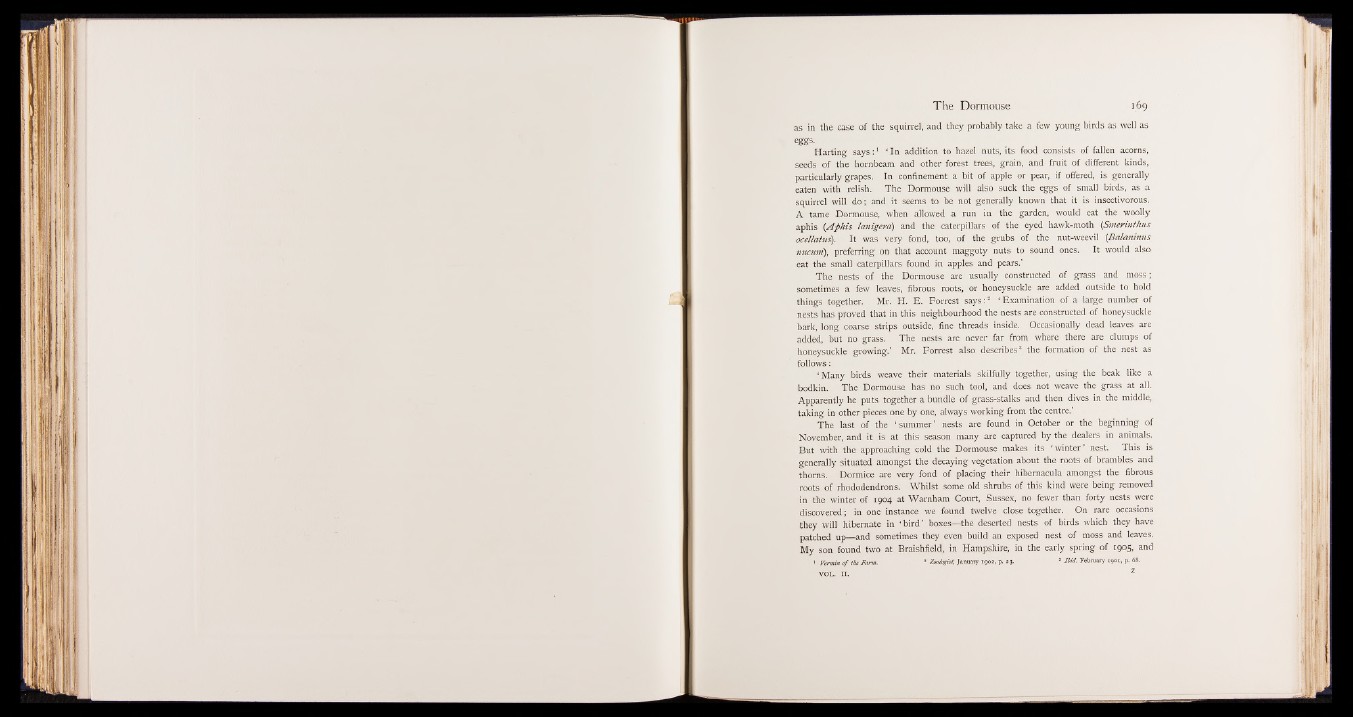
The Dormouse 169
as in the case of the squirrel, and they probably take a few young birds as well as
eggs-
Harting say s : 1 ‘ In addition to hazel nuts, its food consists of fallen acorns,
seeds of the hornbeam and other forest trees, grain, and fruit of different kinds,
particularly grapes. In confinement a bit of apple or pear, if offered,: is generally
eaten with relish. The Dormouse will alsps S c k the, eggSmf small birds, as a
squirrel will d||f and it seems to be not generally known that it Snsectivo rous.,;
A tame Dormouse, when allowed a run in the garden, would eat the woolly
aphis (A ph is lanigera) and the caterpillars of the eyed hawk-moth (Smerinthus
ocellatus). It was very fond, too, of the grubst;:of the nut-weevil (Balaninus
nucum), preferring on that account maggoty nuts to sound ones. It would alsdr
eat the small caterpillars found in app l^and pears.’
The nests of the Dormouse are usually constructed of grass and moss;
sometimes a few leaves, fibrous roots, or honeysuckle are added outside to hold
things together. Mr. H. E . Forrest say,S;# :: ‘ Examination of ifiijarge number of
nests has proved that » t h i s neighbourhood the nests a*|:onstructed of honeysuckle
bark, long coarse -strips outside, fine threads inside. Occasionally . dead leaves' ate:
added, but no grass. The nests are never far from where there are clumps of
hon*ifeuckle growing.’ Mr. Forrest i f i | describes* the formation-vof the nest as
follows:
‘ Many birds weave their materials skilfully together, using the beak like a
bodkin. The Dormouse has no such tool, and.'dpes not weave the grass at all.
Apparently he puts together a bundle o f grass-stalks and then dives in the middle,
taking in other piee'es^one by one, always working from the centre.’
The last of the ‘ summer ’ nests are found in October ||| the beginning of
November, and it is at this season many are captured by the dealers in animals.
But with the approaching hold the Dormouse makes its d winter ’ nest.,. ThiS||S
generally situated amongst the decaying vegetation about the roots of brambles and
thorns. Dormice are very fond of placing their hibernacula amongst the fibrous
roots of rhododendrons. Whilst some old shrubs of this kind were being removed
in the winter of 1904 at Warnham Court, Sussex, no fewer than forty^ndsts were
discovered ^ |n one instance wc found twelve close together. On rare occasions
they will hibernate in ‘ bird ’ boxes—the deserted nests Of birds which they have
patched up—and sometimes they even build an exposed nestirbf mo^s and leaves.
My son found two at BraishfiSld, in Hampshire, in the early spring of 1905, and
1 Vermin o f the Farm. 2 Zoologist\ January 1902, p. 23. 3 Ibid. February 1901, p. 68.
VOL. II.